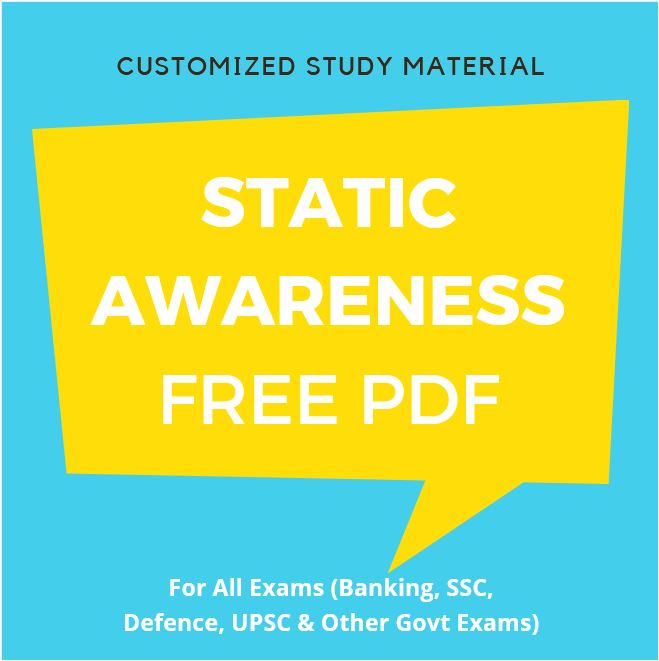Banking Awareness is considered to be the high scoring section in any competitive exam. It includes two main portions, current affairs GK and static GK. In this article, we will discuss some really important Banking Awareness topics that are covered in almost all competitive exams. Also, you can download the PDF of lists of different Banking Awareness topics.
In Banking Section, the questions are asked from following topics: History of Banking, banking terms, Marketing of Banking Products, Functions of Banks, Banks and their taglines, schemes, committees related to banking, headquarters of bank, some Banking news related, apps launched by banks, new schemes etc.
In a series of sharing useful study material for upcoming banking exams. Here, we are providing Banking Awareness notes for all banking Exams (IBPS, SBI & Other Banking Exams).
Banking Awareness Study Notes on Departments of RBI
The Reserve Bank of India influences the management of commercial banks through its various policies, directions and regulations. Its role in bank management is quite unique. It performs the four basic functions such as planning, organizing, directing and controlling in laying a strong foundation for the functioning of commercial banks..
To carry out its functions/operations smoothly and efficiently, the Reserve Bank of India has the following departments.
1. Banking Department:
The Banking Department is responsible for rendering the bank’s services as a banker to the Government and to the banks.
It consists of four sub-divisions:
(i) Public Accounts Department;
(ii) Public Debt Department;
(iii) Deposit Accounts Department; and
(iv) Securities Department.
There are 14 branches of the Banking Department, each headed by a Joint/Deputy Manager.
2. Issue Department:
The Issue Department is concerned with the proper and efficient management of the note issue. For the conduct of monetary transactions, the country has been divided into 14 circles of issue, each having an Office of Issue — the branch of the Issue Department. Each branch of the Issue Department consists of:
(i) the General Department and
(ii) the Cash Department controlled by the currency officer.
The General Department deals with resource operations, i.e., arrangement of supply of notes and coins from the presses and Government Mints. The Cash Department deals with the cash transactions.
3. Department of Currency Management:
This department is concerned with the forecasting of the long-term requirements of the currency, indenting and allocation of currency notes to various branches of the Issue Department taking into account the demand pattern, storage facilities, etc. It is headed by the Chief Officer.
4. Department of Expenditure and Budgetary Control:
This department is concerned with the preparation of the bank’s budget and monitoring of the expenditure of the different units. It is headed by the Financial Controller.
5. Department of Government and Bank Accounts:
This department is concerned with the maintenance and supervision of the bank’s accounts
in the Issue and the Banking Departments and the compilation of weekly statements of affairs and the Annual Profits & Loss Account and Balance Sheet. It is headed by the Chief Accountant.
6. Exchange Control Department:
The Exchange Control department is responsible for controlling foreign exchange transactions and maintaining exchange rate stability.
7. Department of Banking Operations and Development:
This Department was entrusted with the responsibility of the supervision, control and development of the commercial bank system in the country. Till July 1982, it was also concerned with the Lead Bank Scheme and bank credit to the priority sectors.
8. Industrial Credit Department:
The Industrial Finance Department is basically concerned with the administration of the Credit Guarantee Scheme for small scale industries or as agent of the Government of India, with the operational and organisational aspects of the State Financial Corporation’s (SFCs), work connected with the Industrial Development Bank of India (IDBI), data collection about financing of small-scale industries and other relevant problems.
It also deals with the operation and administration of the Credit Authorisation Scheme.
9. Agricultural Credit Department:
This department is mainly responsible for building up of a sound cooperative credit structure in rural financing, supplementing the financial resources of state co-operative banks, providing financial assistance to State Governments to strengthen the co-operative structure, advising Central and State Governments on agricultural and rural credit, formulating policies for taking over of PACs for financing by commercial banks, coordinating the long-term credit activities of State Land Development Banks, etc.
The department also keeps liaison with the Agricultural Refinance and Development Corporation, the Agricultural Finance Corporation, SCBs and LDBs.
With the establishment of the NABARD now, all functions of the Agricultural Credit Department have been transferred to this new institution, except for the supervision and control over the operations of the primary (urban) co-operative banks. The responsibility of supervision and control of PCBs are now shifted to the Department of Banking Operations and Development.
10. Rural Planning and Credit Department:
This department was established in 1982. It is basically concerned with issues like District Credit Plans, Lead Bank Scheme, provision of expert guidance/assistance and processing and sanction of general lines of credit for short-term advances to the NABARD, special studies for promoting IRDP, and for framing the Reserve Bank’s policy on rural development.
11. Department of Non-Banking Companies:
This department administers and controls as well as regulates deposits of non-banking financial companies.
12. Credit Planning Cell:
The Credit Planning and Banking Development Cell have been constituted for the formulation and monitoring of credit policies as well as the developmental aspects of commercial banking.
It chalks out macro-level monetary budgets of the country.
13. Department of Economic Analysis and Policy:
This department conducts economic research and reviews financial and banking conditions in the country. The Economic Department comprises five units:
(i) the Internal Finance Unit;
(ii) International Finance Unit;
(iii) Prices, Production and General Unit;
(iv) Analysis of National Economic Parameters Unit; and
(v) General Unit.
The Economic Department prepares the Bank’s Annual Report, the Report on Trend and Progress of Banking in India, the Report on Currency and Finance, and the Reserve Bank of India Bulletins. It also undertakes ad hoc studies on emerging aspects of banking and other important issues.
14. Department of Statistical Analysis and Computer Services:
Its main function involves the generation, collection, processing and compilation of statistical data relating to the banking and financial sectors from the operational as well as research point of view.
15. Legal Department:
It tenders legal advice on various matters referred to it by the Bank.
16. Inspection Department:
It carries out internal inspections of the offices and departments of the bank.
17. Department of Administration and Personnel:
It looks after the general administration and personnel policy, such as recruitment, training, placements, promotions, transfers, discipline, appeals, service conditions, wage structure, etc.
18. Premises Department:
It is mainly concerned with the construction of buildings for the Bank’s offices, training institutions and staff quarters.
19. Management Services Department:
It is basically concerned with organisational analysis, systems research and development, work procedure studies and codification, manpower planning, costing studies, etc.
20. Reserve Bank of India Service Board:
Its functions involve conducting of examinations/interviews for the selection and promotion of staff in the Reserve Bank.
21. Central Records and Documentation Centre:
It is meant for the preservation of non-current records of the Bank. It provides arrangement for the scientific preservation of records, retrieval service to the enquirer departments, tools of reference such as catalogues, indices, etc.
22. Secretary’s Department:
It attends to the secretarial work connected with the meetings of the Central Board and its committee and of the Administrators of the RBI Employee’s Provident Fund and RBI Employees’ Co-operative Guarantee Fund.
23. Training Establishments:
The Reserve Bank has set-up three prominent training institutions for imparting training in different areas of banking.
These are:
(i) the Banker’s Training College, Bombay
(ii) the College of Agricultural Banking, Pune
(iii) the Reserve Bank Staff College, Madras
There are also Zonal Training Centres situated in Bombay, Calcutta, Madras and New Delhi for conducting induction, functional and short-term preparatory courses for the clerical staff.













